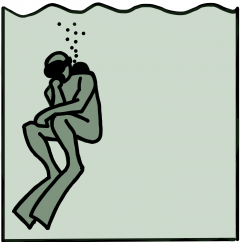One of the features that Subsurface users kept asking for were other deco models besides Bühlmann (including gradient factors). In particular, they wanted to see a bubble model implemented. I was reluctant to do so for some time since I believed (like many other divers) that you can produce fine decompression profiles that look like they are coming from a bubble model by using gradient factors, in particular by using settings like \({GF}_{low}=20-30\). But more important: I did not understand how they worked.
And this is not because I cannot understand how you can derive this or that formula from physical laws (I do that for a living), but because the text that are supposed to describe these models appeared to me to be confused. There were huge gaps in my understanding of the original texts, like this or this, those seemed to me like spending a lot of space on absolutely trivial calculations (like integrating an exponential function) while on the other hand not clearly saying what the actual strategy is and what all those symbols meant. Plus some of the derivations seems to use some slightly unorthodox algebra… There are other texts by other authors that are clearly derived from these originals but I keep having the impression that those secondary authors did not understand the difficult parts either, since many of them are just paraphrasing the originals.
For RGBM there is no hope of understanding it since its inner workings are a trade secret. But the situation of VPM-B is actually better: There is a very concise definition of the model. But it comes in the form of a FORTRAN program by Eric Baker. It is about 75 pages when printed out on paper and it is FORTRAN, so again, the core of the algorithm does not directly present itself to the reader.
Somebody had run this FORTRAN program through f2c but of course the resulting C code is not any more readable. But at least, that allowed be to single step through it with a debugger (rather ran running my finger through 75 pages of spaghetti code). Since then, there are a few more implementation, Since then there are a few more implementations including the C version by Bryan Waite which is at least idiomatic C. But still it follows pretty much in a 1:1 fashion the original FORTRAN code including the separation into sub routines and variable names.
But last summer, there was the opportunity to have a Slagvi, a Google Summer of Code student work on this and do a VPM-B implementation from scratch. I was his mentor and this here is what I learned. Slagvi’s task was not just to link the existing code to Subsurface but really do a reimplementation so that in the process we could understand what is actually going on (and what part of the “explanation” is just a smoke screen).
You can find the result in the subsurface source code, in particular in the two files deco.c and planner.c.
This post here is a start of a series of (to be written) posts that aim at a fresh presentation of how VPM-B works. The next looks at the actual algorithm.


3 thoughts on “VPM-B: How it works (the no non-sense version)”